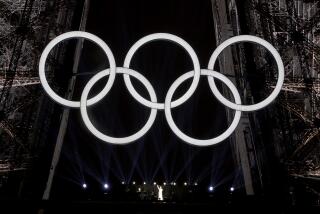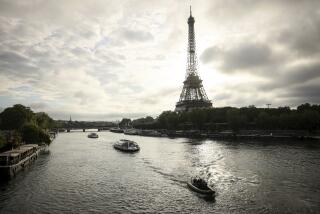PARIS NOTES : It’s Easier to Celebrate the Spa Than the Revolution
- Share via
PARIS — Degas, Zurbaran, late Picasso: There is no lack of major art shows in town, but an annual exhibition that attracts huge crowds and little attention is on right now at the Defense, on the edge of Paris.
The exhibition concerns France’s many spas and the point is, with brochures, smooth talk and computerized displays, to attract the more than half a million French people who go to spas each year.
The French are hardly known for sitting in water or drinking it, but spa vacations have an irresistible lure: With a simple doctor’s letter, the curiste stands a good chance of having all or part of his expenses reimbursed by the French Securitee Sociale, or national health system.
A free vacation is hard to resist and, with a bit of finagling, a stay at a spa can become an extra vacation. Since French companies consider spa cures as sick leave, an employee can still take his statutory five-week summer vacation as well. “Of course, very few people stoop to such behavior,” says a representative of the spa managers organization, the Syndicat National des Establissements Thermaux. Of course.
The reason the annual spa show takes place in winter is because it takes a long time to get medical forms approved and anyway this is not a bad time of year to think of health. The emphasis these days is on fresh air and enjoyment rather than the penitential purity that made Mme. de Sevigne describe Vichy as “a rehearsal for purgatory.”
Vichy is the most famous of France’s more than 100 spas, which considerately divide all the ailments that afflict the human body between them, avoiding useless competition. Vichy, with 12 natural springs, specializes in the liver and kidneys; the tiny spa of Merkwiller-Pechelbronn, near the German border, offers as its sole distraction visits to the local oil museum.
Vittel (liver, nutrition, kidneys) now offers nonthermal attractions such as jogging and riding and a branch of Club Med. Other spas such as Aix-en-Provence, Divonne and Evian offer music festivals; Michel Guerard at Amalie offers cuisine minceur and Aix, when there is no music festival, concentrates on smoking cures and stress.
The biggest boom is in thalassotherapy, which is based on sea, rather than spring, water and involves two advantages: a seaside setting and the fact that the health-giving waters need not be drunk. A main part of the cure is seawater baths to which seaweed is often added, giving the mixture the color and odor of a tubful of commercial travelers’ socks.
The chicest of all is Quiberon on the Breton coast, where such slim beauties as Catherine Deneuve go to rest between films. She stays at the Hotel Fietetique, which lives up to its name by giving guests elegantly presented meals that add up to only 800 calories a day: “It’s not very much,” one steady customer says. “Just enough to keep us from eating each other.”
Now that the French presidential election is in full swing, everyone is looking at the candidates’ posters and clothing rather than listening to what they say. And no wonder: They tend to say the same thing in different ways, but when conservative Raymond Barre made a television broadcast shortly after announcing his candidacy, everyone was talking the next day about the fact that he wore a rather hairy-looking brown suit. The consensus was that plump, professorial Barre was trying to show a new mood of casual confidence to fit in with his campaign poster slogan, which claims it is time to have confidence in France and the French.
Confidence is not a quality the French might be thought to lack, but the slogan seems to please. So far the only major gaffe in vote-seeking happened before the campaign officially began, when Prime Minister Jacques Chirac, trying to win the youth vote, was photographed sitting cross-legged on the grass in jeans, a Walkman over his ears and a chummy grim on his face. The effect was ruined, as everyone quickly noted, by the fact that Chirac was still wearing, with his sneakers, formal black socks.
It was Chirac who, in his capacity of mayor of Paris, canceled the 1989 World’s Fair that was to mark the bicentenary of the French Revolution. His decision caused little comment then but is much regretted now: No one knows how the revolution should be celebrated.
Commissions have been appointed and papers published and studies made. There is no answer in view. In an article headed “1789-1989: The Impossible Revolution,” a Paris daily noted, “A simple question troubles the spirit: What is it that we shall be celebrating in 1989?”
What indeed? The notion of a people rising against injustice is no longer tenable in the cold light of modern history, when no one can agree on who the people were and when the very word is loaded with political overtones.
Were the revolutionaries mere regicides? Did the middle classes storm the Bastille? Was Louis XVI, as one historian maintains, really German with only one-eighth of the blood in his veins French?
The centenary celebrations of 1889 gave the world the Eiffel Tower; no one is sure about the bicentenary, although there is an official Mission du Bicentenaire vigorously making vague plans and taking eager tuition from the United States--not in how to celebrate a bicentenary but in how to attract private funds, le sponsoring as it is called in French.
So far the beneficiaries of the historical confusion are French publishers, who will bring out a total of 800 books covering every aspect of the Revolution from every political side. One privately printed book, illustrated with prints of bloodthirsty hooligans in Phrygian bonnets, is called “Why We Won’t Celebrate 1789.”
In fact, 1789 and the storming of the Bastille will be emphasized. Murkier moments much as the Reign of Terror will be ignored. “We will celebrate 1789, the joyous revolution, and not the bloody events that followed,” says the head of the Mission du Bicentenaire.
The government mint is producing a tricolored 10-franc piece, in which the blue unfortunately didn’t come out, and is selling commemorative jewelry for all tastes--Marie Antoinette and Louis XVI on one side, a symbol of liberty on the reverse. A private company is selling miniature guillotines.
As the Mission du Bicentenaire haltingly tries to organize the impossible anniversary, it has settled into spiffy headquarters on the Left Bank’s rue Talleyrand. The street is named after Charles Maurice de Tallyrand (1754-1838), the statesman who once observed that those who had not lived before the Revolution would never know how sweet life is.
More to Read
Sign up for The Wild
We’ll help you find the best places to hike, bike and run, as well as the perfect silent spots for meditation and yoga.
You may occasionally receive promotional content from the Los Angeles Times.






